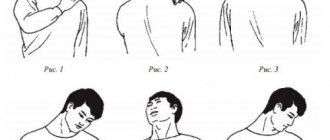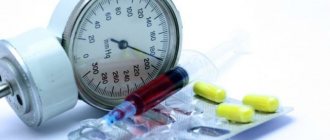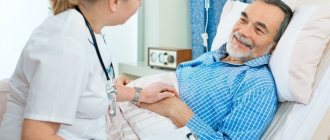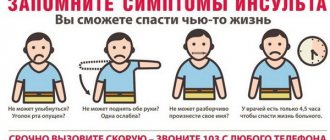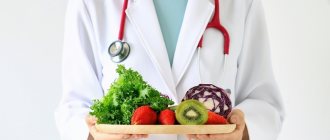- How stroke is related to age and gender
- Controllable risk factors
- What blood pressure can lead to stroke
- Monitoring heart function
- Maintaining normal sugar levels
- Controlling cholesterol levels
- Rejection of bad habits
- Maintaining a Healthy Body Weight
Stroke is otherwise called acute cerebral insufficiency or cerebrovascular accident (CVA).
Depending on the type of disease, ischemic and hemorrhagic stroke are distinguished. In the first case, the cause of the pathology is a blood clot that has blocked the vessel. In the second, there is damage to the vascular wall, which causes bleeding in the brain. In developed countries, strokes are the second leading cause of death. The difficulty for the patient and his relatives is rehabilitation, which takes a long time and requires considerable physical and moral strength.
That is why you need to think about how to prevent a brain stroke and maintain your health. What factors can lead to vascular accident, and how can they be controlled?
How stroke is related to age and gender
Doctors divide risk factors for stroke into controllable and uncontrollable. Among the uncontrollable are gender, age, heredity.
Previously, acute cerebrovascular accident was diagnosed in elderly people over 60 years of age. Due to physiological changes in the body, the risk of vascular pathology in adulthood increases.
Until recently, the proportion of young and middle-aged stroke patients was extremely small. Now, according to statistics, a third of acute stroke cases occur in people aged 20 to 60 years. Rejuvenation of strokes is a trend that doctors associate with the acceleration of the pace of life of the modern generation. This increases the amount of stress and contributes to psycho-emotional overload, which, combined with a lack of physical activity, negatively affects health.
In young and middle age, men are more susceptible to strokes than women, and after 50 years, gender loses its significance. Among elderly patients who have suffered a crisis, the number of men and women is approximately equal. Doctors associate the tendency of the young male population to strokes with bad habits, stress, and neglectful attitude towards their health.
Heredity is another factor that cannot be controlled, but must be taken into account. If your close relatives have cardiovascular diseases, it is recommended to pay more attention to your own health and undergo regular preventive examinations.
Is it possible to prevent a stroke?
Unfortunately, it is not uncommon for patients to become disabled after a stroke. To prevent the sad consequences of acute cerebral circulatory failure, people prone to this disease, as well as their loved ones, should be on alert and not ignore symptoms such as sudden weakness, partial dysfunction of the speech apparatus, numbness of the limbs. Even if the described processes are short-term and pass quickly, they are not less dangerous. The appearance of such precursors of a stroke in your life should prompt you to change your lifestyle. First of all, changes should concern the food system .
It is necessary to reduce the amount of fats, smoked foods, fried foods in your diet, and also use salt as little as possible. Vegetables, fruits, berries - these are the products that should appear on your menu as often as possible. Read material on the topic: Nutrition for the elderly
Numerous studies have concluded that
the likelihood of developing ischemia is reduced by 5% for each serving of plant foods.
First of all, this should include foods enriched with vitamin C, such as greens, citrus fruits, and various types of cabbage. One serving might look like this:
- one apple, banana or orange;
- 150-180g. berries (strawberries, raspberries, currants, gooseberries, blueberries, etc.);
- a glass of fruit juice;
- a tablespoon of dried fruits;
- two tablespoons of vegetables;
- salad dish.
By studying the food preferences of stroke patients and their peers who do not suffer from this disease, Finnish scientists came to the conclusion that eating one apple a day can significantly reduce the likelihood of developing cerebral circulatory disorders.
According to scientists, such a positive effect of apples is caused by the phenolic acids contained in the fruits. This substance belongs to the category of antioxidants - chemical compounds that interfere with the formation of radicals that have a destructive effect on blood vessels. Thus, phenolic acids have a positive effect on blood vessels, reducing the likelihood of their blockage, blood clots and destruction.
What blood pressure can lead to stroke
Hypertension is the very first cause of vascular accidents. With blood pressure above 160/90, the risk of stroke increases fourfold. If blood pressure reaches 200/110 or higher, the likelihood of a stroke increases 10 times. You can control your blood pressure at home using a tonometer. Don't neglect this simple safety measure. Even if you feel well, you may find that your blood pressure is elevated. It is necessary to understand that high blood pressure can be not only an independent disease, but also a symptom of pathology of other organs and systems. This form of hypertension is called secondary. It often affects people with diabetes, kidney disease, and endocrine disorders.
In addition, there is so-called essential (primary) hypertension. Its difference from secondary hypertension is that there are no disorders in the body that could cause an increase in pressure. To identify the exact cause of high blood pressure, you should consult a doctor.
Treatment of any form of hypertension begins with optimizing nutrition and normalizing the daily routine. In order for blood pressure to remain normal, it is necessary to avoid excessive consumption of salt, caffeine, and alcohol. You should avoid physical and emotional overload and devote enough time to rest.
Chronically high blood pressure is treated with medication. The doctor selects a combination of drugs and their dosage.
Kinds
The main classification of strokes (according to ICD-10) takes into account the cause and mechanism of stroke.
- An ischemic stroke is characterized by a cessation of blood flow to the brain tissue. The reason is a violation of blood flow, blockage of an artery with a blood clot and/or narrowing by an atherosclerotic plaque (atherothrombotic), vasospasm, and a decrease in pressure. Most often develops at the age of 50-69 years. The incidence is 64-75% among all types of stroke.
- Hemorrhagic stroke is a hemorrhage into the substance of the brain or under the arachnoid membrane due to rupture of a vessel as a result of high blood pressure, atherosclerosis, vasculitis, aneurysms, coagulation disorders. Patients aged 50-69 years are at high risk. At 39-49 years old it is less common. The incidence is 15-20% among all types of stroke.
There are classifications that distinguish types of stroke taking into account other signs.
1. By severity:
- minor, including microstroke (transient ischemic attack) - a passing disturbance of cerebral circulation with complete disappearance of neurological symptoms within 1 day to 3 weeks;
- moderate severity;
- severe, extensive stroke of the brain - damage to a large area with pronounced neurological symptoms and severe condition, sometimes with falling into a deep coma.
2. By location
- left or right hemisphere. Each side is responsible for different functions, so the symptoms will be different. For example, if the left half is affected, the movements of the right side of the body suffer, speech and memory are impaired. The person loses the ability to read and write.
When the right hemisphere is damaged, the movement of the left side of the body, the perception of oneself, one’s body, and the surrounding space are impaired, and mental disorders develop.
3. By quantity
- primary stroke (first) and repeated strokes (second, third, fourth). Repeated strokes are more severe because the lesion area increases each time.
4. By age
- in children, starting from the prenatal period, young, elderly. The severity of clinical manifestations and prognosis depend on the patient’s age, the cause of concomitant pathology, and the timeliness of diagnosis. The most difficult prognosis is for delayed detection of a stroke, a large lesion, a weakened body due to concomitant diseases, bad habits, and vitamin deficiency.
5. By localization
:
- in the vertebrobasilar basin with damage to the occipital lobe of the brain, cerebellum and brainstem - visual disturbances develop, gait changes;
- frontal lobes - speech and swallowing suffer;
- temporal lobes - memory, writing, speech deteriorate;
- parietal lobe - speech and speech understanding suffer.
Maintaining normal sugar levels
Glucose is necessary for organs and tissues, but its excess content in the blood is fraught with negative consequences for the health of the vascular system. Studies have shown that with diabetes, the risk of stroke increases three to five times, and the disease is characterized by a more acute course and a larger scale of damage. Elevated blood glucose levels have a bad effect on the health of small vessels, leading to poor circulation and damage to the vascular walls. This condition is called diabetic angiopathy.
Diabetics are also susceptible to early development of atherosclerosis: with diabetes, its symptoms are diagnosed 10-12 years earlier than in people without diabetes. Atherosclerosis affects the carotid and vertebral arteries, leading to narrowing of the lumen of blood vessels and impaired blood flow.
To prevent strokes, it is important to regularly monitor glucose levels and avoid overusing foods with large amounts of fast carbohydrates and fat. If a patient is diagnosed with diabetes, it is necessary to adhere to the doctor's recommendations for taking medications and nutrition. Modern medications allow you to keep sugar under control and thereby avoid the negative effects of hyperglycemia on health.
Is it possible to prevent a stroke using folk remedies?
Here is a list of remedies , the use of which is recommended by traditional medicine to prevent the development of stroke, as well as myocardial infarction and other cardiovascular diseases:
- Aloe arborescens (leaves). Before cutting the leaves, do not water the plant for 5 days (the plant should be 3-5 years old). You need to mix 375 g of crushed aloe leaves, 625 g of honey, 675 ml of red wine (preferably Cahors). Infuse the mixture for 5 days in a cool, dark place. For the first 5 days, take 1 tsp. mixture 3 times a day 3 hours before meals, subsequent days - 1 tbsp. l. 3 times a day an hour before meals. The course of treatment is from 2-3 days to one and a half months;
- Elecampane tall (root). 30 g of dry raw material per 1 liter of vodka is infused for 40 days. Take 25 drops before meals. Infusion of elecampane is a wonderful anti-sclerotic remedy for older people;
- Stinging nettle (leaves). In a bottle, 200 g of leaves collected in May are infused into 0.5 liters of vodka. We tie the neck of the bottle with gauze and place it on the windowsill for a day. Then we put it in a dark place. The infusion should be filtered and taken 1 tsp. twice a day: half an hour before meals and at night. This remedy helps reduce cholesterol in the blood and improves heart function;
- Rowan (fruit), oregano (herb) - 20 g each, rose hips - 60 g. Prepare an infusion from 1 tbsp. the resulting mixture per 1 glass of water. Boil and infuse in a porcelain or enamel bowl, add sugar and drink as tea;
- Sarepta mustard. Mustard powder is used in the manufacture of mustard plasters and mustard baths, which have a reflex effect on blood circulation in the body and reduce the risk of stroke.
Controlling cholesterol levels
Excess cholesterol leads to atherosclerosis, which affects the blood vessels of the brain. In their lumen, atheromatous (atherosclerotic) plaques form, due to which blood cannot circulate normally. In severe cases, this leads to blockage of the vessel by a blood clot or rupture, that is, hemorrhage in the brain. The development of atherosclerosis is promoted by smoking, alcohol abuse, and a diet with a predominance of foods containing large amounts of animal fat and trans fats. With diabetes mellitus, excess body weight, immobility, hormonal pathologies, which are accompanied by lipid metabolism disorders, the risk of developing the disease increases many times over.
Atherosclerosis in many cases does not manifest itself externally. Negative symptoms occur when an atherosclerotic plaque has more than half blocked the lumen of the vessel. If the vessels of the brain are affected, this is manifested by emotional lability, deterioration of sleep, decreased memory and attention.
The disease in its early stages can only be determined through medical research. People over 40 years of age, including patients without heart or other pathologies, should be tested for total cholesterol and low-density lipoproteins (LDL) for preventive purposes. We are talking about a lipidogram - a special biochemical blood test. Total cholesterol levels should not exceed 5.7 mmol/l, and LDL levels should be within 1.8 mmol/l.
If there are signs of vascular damage, the doctor additionally prescribes hardware diagnostics: X-ray examination, ultrasound.
Conservative treatment of atherosclerosis involves taking medications to lower cholesterol and prevent blood clots, as well as changing your diet. In severe cases, when a serious blood flow disorder is established, the patient is recommended to undergo surgery.
Drug prevention measures
Most often, doctors use medications on the body. Drugs for the prevention of stroke should be prescribed strictly under the supervision of the attending physician. What do such procedures include?
- Drug correction of blood sugar and cholesterol levels. For these purposes, a drug or complex of drugs is selected;
- Maintaining normal blood pressure levels. If the indicators do not correspond to the norm, then it is advisable to take certain medications for medical reasons;
- Anticoagulant and antithrombotypic therapy;
- Timely treatment of concomitant pathologies of the heart and blood vessels.
Which remedy works well? In this situation, everything depends on the physiological characteristics of the body. Doctors often prescribe bile acid sequesters, statins, antioxidants, drugs that regulate blood pressure, fibrates, components of fish oil and nicotinic acid.
Other types of preventive effects on the body
We have already said above about correcting blood pressure levels and hypertension. It is also necessary to monitor the development of diabetes mellitus, if there is a history of it. Diabetic angiopathy often affects the functionality of cerebral vessels. This can cause severe focal lesions.
You should carefully monitor your diet and adjust your body weight. The diet should not contain foods rich in fat and cholesterol. It is important to avoid physical inactivity, and therefore it is worth paying attention to massage, exercise therapy, swimming in the pool or other types of physical activity that regulate blood circulation and blood pressure in the body.
You should also monitor your emotional state. We must try to avoid excessive stressful situations.
Stroke in old age can have serious consequences for patients. The recovery period lasts quite a long time, and many older people cannot regain lost functions. In private boarding houses “Caring for Loved Ones”, high-quality care for the elderly after a stroke is provided based on developed tactics that give real positive results. Experienced specialists work with elderly people, surrounding them with maximum attention and care.
Rejection of bad habits
Alcohol abuse and smoking increase the risk of stroke by three to four times. Smokers have increased stress on the walls of blood vessels, which is caused by exposure to nicotine. Tobacco users are more likely to suffer from hypertension, heart failure and other pathologies that increase the risk of stroke.
Alcoholic drinks destroy the walls of blood vessels. They become more brittle. Drinkers have an increased risk of hemorrhagic stroke, which involves bleeding in the brain. Alcohol abuse also negatively affects the state of platelets. This can lead to the formation of blood clots and blockage of blood vessels in the brain. Tissues stop receiving oxygen, which leads to their death.
Scientists have found that daily consumption of three or more glasses of drinks with a high content of ethyl alcohol contributes to the development of stroke at a younger age. For people who drink, their first stroke most often occurs between the ages of 50 and 60. This is due to premature degenerative changes in vascular tissues caused by exposure to alcohol. In patients without alcohol dependence, vascular accidents mostly occur at the age of 70-75 years.
Like smokers, drinkers often suffer from hypertension, which is the biggest risk factor for stroke.
Giving up bad habits will significantly reduce the load on the cardiovascular system and increase the effectiveness of treatment.
The first warning signs of a stroke
In the vast majority of cases, approximately one day before a stroke, periodic disruptions in the movement of blood through the vessels of the brain begin to occur, which manifests itself in the following symptoms :
- headache;
- general discomfort;
- temporary disorder of consciousness.
Typically, an ischemic cerebral stroke develops within a few hours, but in some cases this process takes several days. The first symptoms appear at night or in the morning, appearing and disappearing. The face acquires a pale and sometimes blue tint, the sensitivity of the skin decreases, and disturbances in olfactory, speech and visual functions are observed. The patient may not recognize people and objects. Hemiparesis is observed on the side of the body opposite the brain hemisphere affected by the stroke. A hemorrhagic stroke usually has no warning in advance. An attack occurs during the greatest physical and mental stress, that is, as a rule, during the day. Symptoms of a hemorrhagic stroke sudden changes in body temperature, sweating, a red complexion, a jump in blood pressure and difficulty breathing. The patient feels a severe headache and faints. Using the so-called “sail” symptom , in which one of the patient’s cheeks inflates when exhaling, a hemorrhagic stroke can be diagnosed. It can also be identified by weak muscle tone and everted foot.
Maintaining a Healthy Body Weight
Excessive accumulation of fat deposits, especially in the abdominal area, increases the risk of stroke. People who are overweight are more likely to have type 2 diabetes and other diseases that cause complications on the heart and blood vessels. Also, people of heavy build are more likely to suffer from high blood pressure. All these factors together create a risk of stroke.
To maintain a healthy weight, you need to monitor your diet, control your hormonal levels, and ensure adequate physical activity. The most beneficial for blood vessels are aerobic exercises. These are walking, race walking, cycling, swimming.
Women taking hormonal contraceptives should be especially attentive to their health. Such drugs increase appetite, and if the dosage is incorrectly selected, the risk of vascular damage increases.
FAQ
How is a stroke different from a heart attack?
Cerebral infarction is one of the types of stroke and it is ischemic in nature, i.e. accompanied by a cessation of blood flow to the brain. A characteristic feature is the gradual development of the clinical picture and the predominance of focal symptoms: disturbances in speech, vision, gait, movements up to paralysis, sensitivity.
Can a stroke and heart attack happen at the same time?
If we consider only the brain, mixed stroke occurs, when the causes of stroke include both hemorrhage and ischemia. They can occur simultaneously when a vessel ruptures in one area and blood flow stops in another. Also, ischemia can develop at the site of subarachnoid hemorrhage after some time.
If we consider a heart attack as a heart disease, then these conditions can also be diagnosed simultaneously. Moreover, a stroke can develop as a result of a heart attack: the functioning of the heart suffers, and insufficient blood flows to the brain. This is how we get a stroke.
Does a stroke only occur in the brain?
Stroke (Latin insultus “swoop, attack, blow”) is an acute disruption of the blood supply to the brain due to ischemia (infarction) or hemorrhage. If ischemia occurs in other organs, it is also called a heart attack. For example, myocardial infarction, intestinal, kidney, etc. It is characterized by severe pain, dysfunction of the affected organ and other symptoms.
Does stroke occur with normal or low blood pressure?
Arterial hypertension is one of the main, but not the only causes of stroke. Thrombosis, atherosclerosis, and diabetes mellitus, in which blood pressure is normal or even reduced, are also risk factors. In addition, with low pressure, the brain is not sufficiently supplied with oxygen, which is a prerequisite for the development of ischemic stroke.
Do children have strokes?
Stroke is also diagnosed in children. It can develop even in the perinatal period. Causes: abnormalities in the coagulation system, pathologies of the cardiovascular system, including vascular malformations, bad habits of the mother during pregnancy, oxygen starvation during childbirth, trauma.
In the perinatal period and up to one year, the disease is accompanied by anxiety, frequent crying, loss of appetite, impaired reflexes in the newborn period, strabismus, and convulsions. The diagnosis is made based on an examination by a pediatric neurologist, ultrasound of the brain, and tomography results. At older ages, symptoms are similar to those of stroke in adults.
The child's body is more flexible and responds more quickly to therapy. The main thing is to diagnose a stroke in time and begin treatment.
Can a stroke go away on its own?
There is such a condition - transient stroke. It is accompanied by a short-term circulatory disorder, but no irreversible changes in brain tissue occur. The external manifestations of such a stroke are the same as a normal one, but less pronounced: headache, dizziness, darkening of the eyes, changes in sensitivity in various parts of the body. And they pass within 24 hours. However, the condition requires qualified treatment and rehabilitation, elimination of risk factors, because in the future there is a possibility of a secondary stroke.
At what pressure can a stroke occur?
A stroke can develop at any pressure. Arterial hypertension causes hemorrhagic stroke, hypotension causes ischemic stroke.
Do pine cones help prevent stroke?
Pine cones lower blood pressure, so they should not be consumed if you have hypotension. The effect is due to the tannins contained in the buds. The composition also contains vitamins C and P - they strengthen the walls of blood vessels and improve blood circulation.
The advisability of using products based on herbal raw materials is decided by the attending physician after a detailed examination. In general, pine cones for stroke can only be used as a complementary method.
Symptoms of a microstroke
- Sharp and severe headache.
- Sudden memory loss, difficulty understanding and constructing speech.
- Loss of balance and coordination.
- Numbness in an arm or leg, numbness in one part of the face.
- Severe sound and photophobia.
In case of a micro-stroke, a person can be helped within 4 hours. It is necessary to seek help as soon as possible - either go to the vascular center or call an ambulance.
65% of patients subsequently develop a full-fledged stroke after a mini-stroke, so it is necessary to promptly treat and restore normal blood circulation in the brain.
